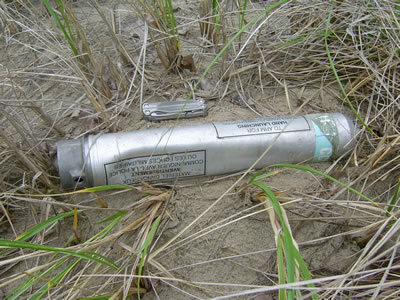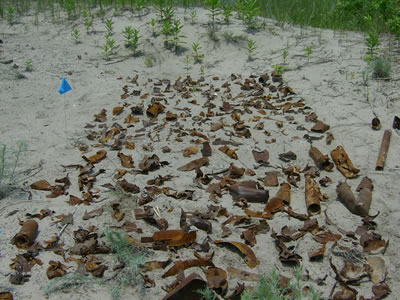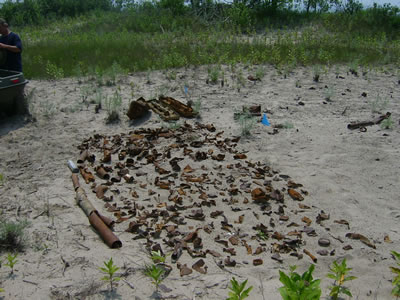
|
|
TOPICS |
|
What's New |
|
|

The UXO Hazard at Wellers Bay
National Wildlife Area and Surrounding Waters
Location
The Wellers Bay National Wildlife Area consists of several islands and connecting sand spits in Lake Ontario close to the towns of Consecon and Brighton, Ontario, in Prince Edward County. It includes Bald Head Island, Fox Island, the northern portion of Bald Head Peninsula, and several connecting parcels of land amounting to approximately 80 acres in total.
Topography and Vegetation
The area is relatively flat, consisting mainly of sand dunes on the protected Wellers Bay side, and a rocky shoreline on the Lake Ontario side. The topography is constantly shifting due to heavy erosion caused by changing water levels, wind and wave action, and the movement of ice during the winter.
History
From 1939 to 1953, Wellers Bay was home to the Consecon Air Weapons Range. During that period, thousands of bombs, rockets and explosive projectiles were directed at targets in the area. The range danger area was described in 1954 as a circle of 2000 yard’s radius around a centre point on or near the spit at 44° 00’ 00”N, 77° 35’ 30”W.
In the early 1950s, the range ceased to be used and, in 1969, was transferred to the Department of Indian Affairs and Northern Development on the strict condition that it be used only as a conservation area for waterfowl.
In 1978, with DND’s permission, the lands were transferred to Environment Canada and designated as Wellers Bay National Wildlife Area (NWA) in accordance with the Canada Wildlife Act. The Canadian Wildlife Service is currently responsible for the NWA and manages it with the goal of protecting the integrity of its habitat for the benefit of migratory birds. DND retains jurisdiction over the lakebed within a safety zone extending under the waters of Wellers Bay and Lake Ontario which were once part of the Consecon Range. It is marked on nautical maps as an exclusion zone.
Types of Ammunition Used
Bombs: 500 lb GP / V.T. fuzed / tritonal filling (278.2 lbs per unit). These heavy bombs may have penetrated the sand or lake bottom to a substantial depth;
Practice Bombs: 11½ or 16½ lb containing a cartridge composed of smokeless powder (phosphorous composition). These charges can cause serious burns and loss of eyesight;
Training Rockets: 2.25” and 3” inert – nitroglycerin-based rocket motor propellant, with inert rocket warheads and motor casings. Propellant remains sensitive to heat and is subject to detonation.
Other Ammunition: 20mm high explosive (HE) rounds. This ammunition was fired by aircraft during strafing practice. Each round contains a small explosive charge.
Recent Research and Survey Work
- Historical research completed in May 2006, conducted to verify the quantity, types and locations of munitions dispensed.
- An Environmental Assessment conducted in June 2006, under the supervision of Environment Canada. The Assessment prescribed mitigation measures to be following during Phase I and II clearance operations.
- A Phase I Surface Clearance completed in June 2006, which removed 250 kilograms of munitions scrap.
- A Phase II Geophysical Survey and Limited Subsurface Clearance completed in October 2006.
The work was carried out by experienced private companies contracted by DND through a competitive bid process.
Key Findings
The work completed to date verifies that there is reason for concern about the safety of people entering this area. The geophysical survey has lead to the discovery of several live munitions along with rocket engines that still contained their explosive fuel. The geophysical survey data also indicate the widespread presence of near-surface munitions and munitions-related items throughout Bald Head spit, beach areas and shallow water. There are several geophysical features on land and in the shallow water areas that have magnetic signatures essentially identical to that of a 500 lb bomb and could represent the missing 500 lb bombs.
Some of the highest concentrations of geophysical anomalies are in “blow through” areas of the spit – areas most likely to be affected by heavy weather. With the amount of magnetic anomalies identified in these areas, live ordnance could be uncovered by any storm.
DND’s advice to the public: stay out of the area. The recent work confirms that it is dangerous.
Next Steps
Technical survey work will continue over the 2006-2007 winter months using an airborne magnetometer over an area of 812 hectares. The magnetometer survey will enable investigators to add a great deal of data in areas that were not investigated specifically during the Phase II survey. Together with the results of earlier investigations, the findings will be used by DND’s Explosive Risk Rating Sub-Committee to make a final determination of the level of public risk in the area, and to determine if range clearance activities are warranted. To protect the public, DND will be putting up a new set of warning signs around the affected area early in the spring.

Wellers Bay - Ontario

Rocket, 3-inch, AR

Marine Marker MK25

Rocket Motor, 3-inch

Munitions Scrap

From left to right - Rocket Motor, 2.25-inch; Rocket Motors, 3-inch; Marine Marker

Munitions Scrap

Munitions Scrap Area
| Publication Date: 2006 11 17 | Important Notices |

